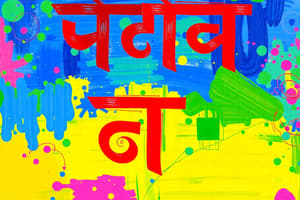Podcast
Questions and Answers
Which historical influence primarily led to the development of Hindustani, encompassing both Hindi and Urdu?
Which historical influence primarily led to the development of Hindustani, encompassing both Hindi and Urdu?
- The Delhi Sultanate and Mughal Empire (correct)
- The Maurya Empire
- British Colonial rule
- The Gupta Empire
The gender of a noun in Hindi can always be predicted based on its ending.
The gender of a noun in Hindi can always be predicted based on its ending.
False (B)
What script is used to write Hindi?
What script is used to write Hindi?
Devanagari
Hindi uses ______ instead of prepositions.
Hindi uses ______ instead of prepositions.
Match the Hindi expression or word with its appropriate meaning.
Match the Hindi expression or word with its appropriate meaning.
Which of the following sentences best describes the standardization of modern Hindi?
Which of the following sentences best describes the standardization of modern Hindi?
Bhojpuri is always considered a dialect of Hindi and is mutually intelligible with Standard Hindi.
Bhojpuri is always considered a dialect of Hindi and is mutually intelligible with Standard Hindi.
What role has Hindi cinema (Bollywood) played in the spread of the Hindi language?
What role has Hindi cinema (Bollywood) played in the spread of the Hindi language?
Hindi verbs are conjugated based on tense, aspect, mood, number, and ______ of the subject.
Hindi verbs are conjugated based on tense, aspect, mood, number, and ______ of the subject.
What is the most accurate comparison between formal Hindi and Urdu?
What is the most accurate comparison between formal Hindi and Urdu?
Flashcards
What is Hindi?
What is Hindi?
An Indo-Aryan language spoken chiefly in India and an official language of the Government of India.
Origin of Hindi
Origin of Hindi
Early forms of Prakrit through Shauraseni Apabhramsa.
Hindi Belt
Hindi Belt
Uttar Pradesh, Madhya Pradesh, Bihar, Haryana, Rajasthan, Himachal Pradesh, Uttarakhand, Jharkhand, and Chhattisgarh.
Devanagari script
Devanagari script
Signup and view all the flashcards
Hindi word order
Hindi word order
Signup and view all the flashcards
Vocabulary of Hindi
Vocabulary of Hindi
Signup and view all the flashcards
Hindi vs. Urdu Vocabulary
Hindi vs. Urdu Vocabulary
Signup and view all the flashcards
Bollywood's influence on Hindi
Bollywood's influence on Hindi
Signup and view all the flashcards
Code-Switching
Code-Switching
Signup and view all the flashcards
Postpositions in Hindi
Postpositions in Hindi
Signup and view all the flashcards
Study Notes
- Hindi is an Indo-Aryan language spoken chiefly in India
- It is the official language of the Government of India, alongside English
- Hindi is also an official language in Fiji
Origin and History
- Hindi evolved from the early forms of Prakrit through Shauraseni Apabhramsa
- Modern Standard Hindi is based on the Khariboli dialect of Delhi and surrounding regions
- The standardization process of Hindi occurred mainly in the 19th and 20th centuries
- Hindi has roots in Sanskrit
- During the Delhi Sultanate and Mughal Empire, the language absorbed Persian, Arabic, and Turkic influences, leading to the development of Hindustani
- Hindustani encompasses both Hindi and Urdu, which share a common colloquial base but diverge in literary and formal vocabulary
Geographical Distribution
- Hindi is spoken across the "Hindi Belt" of India, including states like Uttar Pradesh, Madhya Pradesh, Bihar, Haryana, Rajasthan, Himachal Pradesh, Uttarakhand, Jharkhand, and Chhattisgarh
- Significant Hindi-speaking populations exist in other parts of India, such as Maharashtra, Punjab, and West Bengal
Official Status
- Hindi is one of the two official languages of the Union Government of India
- The Constitution of India recognizes Hindi as the official language to be used for official purposes
- English also serves as an additional official language
- At the state level, Hindi is the official language of several states within the Hindi Belt
Writing System
- Hindi is written in the Devanagari script
- Devanagari is an abugida, where each consonant has an inherent vowel
- Vowels can be written as independent letters or using diacritics attached to consonants
- The script is written from left to right
Linguistic Features
- Hindi is an Indo-Aryan language, closely related to other languages like Punjabi, Gujarati, Marathi, and Bengali
- It exhibits subject-object-verb (SOV) word order
- Hindi has a rich system of postpositions rather than prepositions
- Grammatical gender is a significant feature, affecting agreement between nouns, adjectives, and verbs
- Hindi verbs are conjugated based on tense, aspect, mood, gender, and number
Vocabulary
- The vocabulary of Hindi is largely derived from Sanskrit and Prakrit
- It includes loanwords from Persian, Arabic, and English
- Modern Hindi is consciously incorporating more Sanskrit-based vocabulary to promote its distinct identity from Urdu
Differences between Hindi and Urdu
- Hindi and Urdu are considered mutually intelligible at the colloquial level
- They diverge in their formal and literary vocabulary
- Hindi draws heavily from Sanskrit, while Urdu incorporates Persian and Arabic words
- Hindi is written in the Devanagari script, while Urdu uses a modified Perso-Arabic script
- The standardized forms of Hindi and Urdu are quite distinct, especially in written form and formal speech
Influence of Hindi
- Hindi cinema (Bollywood) has played a significant role in popularizing and spreading the Hindi language across India and abroad
- Hindi songs and movies are widely consumed and understood in many parts of South Asia and among the Indian diaspora worldwide
- The influence of Hindi is also seen in Indian television, radio, and print media
Dialects
- Several regional dialects exist within the Hindi-speaking area
- These dialects include Awadhi, Braj Bhasha, Bhojpuri, Bundeli, and Chhattisgarhi
- While these dialects are related to Hindi, they have distinct features and may not be mutually intelligible with Standard Hindi in all cases
- Some dialects, like Bhojpuri, are sometimes considered separate languages due to their distinct characteristics and large number of speakers
Learning Hindi
- Hindi is taught as a subject in schools across India
- Many universities offer courses in Hindi language and literature
- Various online resources and language learning apps are available for those interested in learning Hindi
- Due to the global presence of the Indian diaspora, Hindi is also taught in some schools and universities outside of India
Grammatical Gender
- Hindi has two genders: masculine and feminine
- Nouns are assigned a gender, which affects the forms of adjectives and verbs that agree with them
- The gender of a noun is not always predictable and must often be memorized
- Gender agreement is a fundamental aspect of Hindi grammar
Verb Conjugation
- Hindi verbs are conjugated based on tense, aspect, mood, number, and gender of the subject
- Different verb endings are used to indicate these grammatical categories
- Auxiliary verbs are often used to form compound tenses and aspects
- Verb conjugation is essential for constructing grammatically correct sentences in Hindi
Postpositions
- Instead of prepositions (which come before the noun), Hindi uses postpositions that follow the noun
- Common postpositions include ko (to, for), se (from, with), me (in), and par (on)
- Postpositions are crucial for indicating relationships between nouns and other parts of the sentence
Compound Verbs
- Hindi frequently uses compound verbs, which consist of a main verb followed by an auxiliary verb
- Compound verbs can express nuances of meaning such as completion, intention, ability, and obligation
- They add complexity and expressiveness to the language
Loanwords
- Hindi has absorbed many loanwords from other languages throughout its history
- Persian and Arabic loanwords are particularly common, reflecting the historical influence of these languages in the region
- English loanwords are increasingly used in modern Hindi, especially in urban areas and in technical or scientific contexts
Common Expressions
- Namaste is a common greeting in Hindi, meaning "I bow to you."
- Aap kaise hain? means "How are you?" (formal)
- Tum kaise ho? means "How are you?" (informal)
- Shukriya means "Thank you."
- Dhanyavaad is another way to say "Thank you."
- Theek hai means "Okay" or "Alright."
- हाँ (haan) means "Yes".
- नहीं (nahin) means "No".
Code-Switching
- Code-switching, the practice of alternating between two or more languages in conversation, is common among Hindi speakers, particularly in urban settings
- Hindi speakers may switch between Hindi and English depending on the context, topic, and interlocutors
- Code-switching reflects the multilingual environment in India and the influence of globalization
Contemporary Trends
- Modern Hindi is evolving to meet the needs of a changing society
- There is a growing emphasis on using Hindi in technology, science, and other fields
- Efforts are being made to promote the use of Hindi in government, education, and public life
Studying That Suits You
Use AI to generate personalized quizzes and flashcards to suit your learning preferences.



